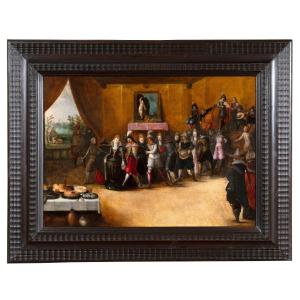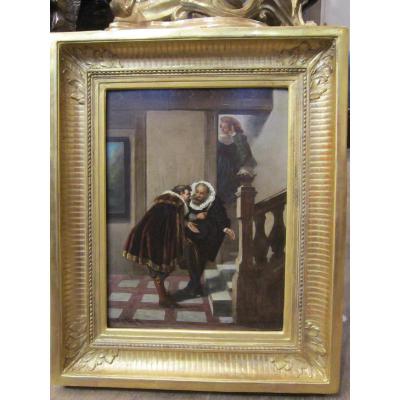Attributed to Hieronymus Francken II (Antwerp 1578-1623)
Early 17th century Antwerp school
Oil on oak panel,
Dimensions: H. 52.5 cm, W. 74 cm.
Flemish-style moulded wood frame
Frame: h. 78 cm, w. 100 cm
At first glance, this festive and joyful painting depicts a group of elegantly dressed people dancing to the sound of an orchestra in a richly decorated interior with a wide opening onto a rural exterior. However, the real theme is cleverly concealed by the painter and is only discernible through the artifice of a small scene in the background where we see a half-naked man, in the company of the pigs next to a makeshift shelter.
In fact, beyond the pleasant and apparently superficial character of the painting, it is a subject taken from the parable of the prodigal son in the Gospel. The illustrated episode is the prodigal son among courtesans.
Even if the viewer's attention is drawn to the central couple (prodigal son embracing a pretty courtesan) doing the dance steps, the artist takes care in a narrative approach of all the groups and ancillary scenes in order to create a rich and varied composition. Thus the musicians seated on a raised platform are depicted with great skill, their faces animated, their clothes abundantly varied.
The theme of music, which has always been associated with that of sensuality and physical love, helps to exacerbate licentious pleasures.
The merry company dances "Spanish pavane", a slow court dance from the sixteenth century, danced close to the ground by couples arranged in a procession, which was probably introduced to the south of the Netherlands around 1600 during the governance of Albrecht VII and the daughter of the King of Spain Isabella Clara Eugenia in Brussels.
The interior of the house is also carefully elaborated, the embossed leather dyes on the walls, the middle sideboard (typical in Francken interiors), where the rich gold and silver crockery is placed in front of the painting "Andromeda chained to the rock and Perseus arriving to rescue her". The inclusion of a contemporary and probably extant pictorial work is also one of the characteristics of the Francken family, among them Frans Francken the Younger is particularly known for his numerous interiors of amateur cabinets.
In the foreground, on the left, a table laden with fine food and precious crockery indicates the banquet that took place before the dance. The painter places several objects whose symbolism serves to reinforce decay and abuse: glasses filled with wine (drunkenness), a knife whose handle leans unbalanced at the edge of the table (instability), open oysters (the image of carnal pleasure), a broken lemon (a life started: symbol of the bitterness of the passing of time).
Finally, in the third left ground, two men standing, wrapped in cloaks, look at the whole scene, one can easily imagine two bandits who have arrived to steal the prodigal son's money, their weapons hidden under their coats. No matter how it happens again, the prodigal son will end up ruined, even leaving his shirt there, and this is how the painter depicts him in the background: kneeling among the pigs, he seems to reflect on his downfall and decides to return to his father. In reality, the Gospels remain very discreet about the details of the debauchery life of the young man who went to squander his inheritance, yet there is a whole tradition in Antwerp painting from the sixteenth century onwards to complacently depict the debauchery of the prodigal son: meal, drink, gambling, courtesans. This technique makes it possible to divert a religious subject into a secular one.
The story of the Prodigal Son, which is constantly in the moralizing spirit, also serves as a pretext to point out licentious and amoral behavior. The decay embodied by the eviction from the brothel and life among the pigs are always relegated to the background. The proscenium, on the other hand, emphasizes the pleasures of music, dance and the flesh. Sin is absolute! This way of representing ball scenes in an interior at the Francken house would come from Hieronymus I Francken (around 1540-1610), who worked at the court of France at the end of the sixteenth century and was inspired by the many balls that took place there. His nephews, Frans Francken II and Hieronymus Francken II, were inspired by their uncle's compositions while adapting the ballroom scenes to their Flemish clientele, incorporating biblical morality against excesses into their works.
Related works:
Some works are very close to our painting with some minute variations in the setting or the characters' clothes.
• Koller auction, Zurich, 22/03/2013, oil on copper, by Hieronymus Francken II, signed DEN ION franck f (h. 44,5 cm, w. 65,5 cm)
• Christie’s New York 31/01/2013, oil on panel, h. 61 cm, w. 85 cm, by Hieronymus Francken II
• Musée de Tessé, Le Mans, After Hieronymus I Francken (Herenthals c. 1540 - Paris 1610) Ball during the reign of Henri III, oil on panel
• Private collection, illustrated in Ursula Harting, dated 1607, by Hieronymus Francken II, p.178 n. 150 (Frans Francken Der Jüngere (1581-1642). Die Gemalde mit kritischem oeuvrekatalog, 01/01/1989 Edition : Luca Verlag, monography on Frans Francken the Younger as well as his family)
Other compositions differ from ours, but have many similarities:
• The Prodigal Son Among Courtesans, Musée des Beaux Arts de Nimes, by Hieronymus I Francken, oil on panel
• Dance lesson, Musée des Beaux-Arts de Cambrai, by Hieronymus Francken II, oil on panel, h. 54 cm, w. 80 cm,
• The Prodigal Son Among Courtesans, Musée de Brou, Bourg-en-Bresse, by Frans Francken II, oil on copper, h. 40 cm, w. 52 cm, , signed Do. Franck
• Dancing company, Lempertz Auction, Köln, 14 May 2011, by Hieronymus Francken II, oil on panel, h. 49,5 cm, w. 71 cm
Hieronymus Francken II (Antwerp 1578-1623)
Hieronymus Francken II was the son of Frans Francken the Elder. His father was a painter born in Herentals who had moved with his painter father to Antwerp. There he had become one of the leading painters of the Counter-Reformation. Hieronymus had three painter brothers: Thomas, Frans II, and Ambrosius II. Hieronymus received his first training from his father. He was entered in the books of the Antwerp Guild of St. Luke in 1605 as a pupil of his uncle Ambrosius. In 1607, Hieronymus Francken II was officially admitted as Master of the Antwerp Guild. In 1609 he probably spent time in Paris, where, like his brother Frans II, he is said to have studied under his uncle Hieronymus Francken I. Hieronymus Francken I worked most of his life in Paris and Fontainebleau and was court painter to France from 1594. Hieronymus Francken II returned to Antwerp where he spent the rest of his life.
Hieronymus Francken the Younger was a versatile artist who practiced many genres. Hieronymus painted art galleries and cabinets of curiosities, genre scenes of balls and gallant dances, history paintings, antics, allegorical paintings, and still lifes. He also copied some witchcraft scenes, invented by his brother Frans II.



































 Le Magazine de PROANTIC
Le Magazine de PROANTIC TRÉSORS Magazine
TRÉSORS Magazine Rivista Artiquariato
Rivista Artiquariato